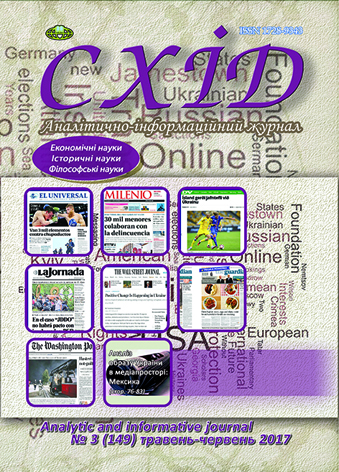Public opinion - regular nature of the formation
DOI:
https://doi.org/10.21847/1728-9343.2017.3(149).108348Keywords:
public opinion, regularity, consciousness, life, interactionAbstract
At the present stage of political life public opinion endures the increase of its role and significance thus determining the relevance of social and philosophical analysis of the public opinion phenomenon. This article aims to represent more profoundly the process of public opinion formation, and to substantiate its regular character.
Theoretical knowledge of ontological foundation of the phenomenon under consideration requires the reliance on laws of the dialectic: unity and struggle of opposites (while creating public opinion social subjects together denote a unity in relation to the subject of dispute, and at the same time they are in conflict regarding its evaluation), transition from quantitative to qualitative changes (as public opinion changes and acquires new qualities at each stage of formation), negation of the negation (although public opinion endures typical formative stages, it nevertheless retains the holistic nature).
Due to the analysis of public opinion definitions made by well-known representatives of internationl and national science (F. Allport, Ye.Noel-Neumann, O.Uledova, V.Shatun etc.) it was determined that the phenomenon of public opinion has subject-object nature, its formal trait is social activity and information and emotional interaction. It was established that public opinion is formed in accordance with the facts of human life, under conditions when human needs and interests are implemented due to the influence of the environment, public relations, and other realities of social life. However, the essential role in this process also belongs to the fundamental understanding and background assumptions, standards, ideas and values created by public conscience.
So it is proved that the formation of public opinion is possible due to the interaction of two major components - a social being and social consciousness. It is the interaction of rational, emotional and conative components of social subjects and objects of public opinion.
The relationship of social consciousness and social life is stable, objective, substantial, internal, necessary and repetitive, and, therefore, it appears as the main pattern of public opinion formation.Downloads
References
Gavra, D.P. (1995), Obschestvennoe mnenie kak sotsiologicheskaya kategoriya i sotsіalnyiy institut [Public opinion as a sociological category and social institution], ISEP,Saint Petersburg, 235 р. (rus).
Ganchev, D. (1983), Izuchenie i formirovanie obschestvennogo mneniya [Study and formation of public opinion], Myisl, Мoscow, 208 р. (rus).
Gorshkov, M.K. (1988), Obschestvennoe mnenie : istoriya i sovremennost [Public opinion: history and modernity], Іzdatelstvo politicheskoy literatury, Moskva, 384 р. (rus).
Holtzendorff, F. (1985), Obshchestvennoe mnenie [The Public Opinion]. (N. Ber, Trans), Tsentralnaia Tipo-litohrafiia M.Ya. Minkova, Saint Petersburg, 131 р. (rus).
Korobeynikov, V. (1981), Piramida obschestvennogo mneniya [Pyramid of public opinion], Molodaya gvardiya, Мoscow, 221 р. (rus).
Gvishiani, D.M & Lapina, N.I. & Korzheva, E.M. & Naumova, N.F. (Eds). (1989), Kratkiy slovar po sotsiologii [Brief Dictionary of Sociology], Politizdat, Мoscow, 477 р. (rus).
Zadorozhnyuk, I.V. (1998), Sotsialnaya psihologiya : sbornik G. Lebon «Psihologiya tolp». G. Tard «Mnenie i tolpa» [Social psihologіya: collection G. Lebon «The psychology of crowds» G. Tard «Opinion and the crowd»], Institut psihologii RAN, Izdatelstvo «KSP+», Мoscow, 416 р. (rus).
Uledov, A.K. (1963), Obschestvennoe mnenie sovetskogo obschestva [Public opinion of Soviet society], Іzdatelstvo sotsialno-ekonomicheskoy literatury, Мoscow, 391 р. (rus).
Shinkaruk, V.I. (Eds). (2002), Filosofskiy entsiklopedichniy slovnik [Encyclopedic Dictionary of Philosophy], Abris, Kyiv, 742 р. (ukr).
Shatun, V.T. (2012), Kontsept gromadskoyi dumki [The concept of public opinion]. Naukovi pratsi, Politologiya, 192, рр. 52-56 (ukr).
Allport, F. H. (1920). The influence of the group upon association and thought, Journal of Experimental Psychology, 3 (3), рр. 159-182 (eng).
Noelle-Neumann, Е. (1984), The Spiral of Silence. Public Opinion - Our Social Skin, Chicago University Press, Chicago, 277 р. (eng).
McLuhan, M. & Hutchon, K. & McLuhan E. (1977). City as Classroom: Understanding Language and Media. The Book Society of Canada Limited, Canada, 184 р. (eng).
Burstein, Paul (2003), The Impact of Public Opinion on Public Policy: A Review and an Agenda, SAGE Journals, Volume: 56 issue: 1, pр. 29-40. DOI: 10.1177/106591290305600103.
Druckman, James N.& Peterson, Erik & Slothuus, Rune (2013), How elite partisan polarization affects public opinion formation, American Political Science Review, Vol.107, Issue 1, p. 57-79. DOI: 10.1017/S0003055412000500.
Moussaїd, Mehdi & Kämmer, Juliane E. & Analytis, Pantelis P. & Neth, Hansjörg (2013), Social Influence and the Collective Dynamics of Opinion Formation. PLoS ONE 8(11): e78433. DOI: 10.1371/journal.pone.0078433.
Downloads
Published
How to Cite
Issue
Section
License
Copyright (c) 2017 Olena Starykovska

This work is licensed under a Creative Commons Attribution-NonCommercial-NoDerivatives 4.0 International License.
1. Authors bear responsibility for the accuracy of facts, quotations, numbers and names used.
2. Manuscripts are not sent back.
3. The publisher does not always agree with the authors' opinion.
4. The authors reserve the right to authorship of the work and pass the first publication right of this work to the journal under the terms of a Creative Commons Attribution-NonCommercial-NoDerivatives 4.0 International License. This license allows others to distribute (copy) the published work for non-commercial purposes, provided there is mandatory attribution to its authors and a link to the first publication in our journal.
5. The authors have the right to conclude separate supplement agreements that relate to non-exclusive work distribution in the form in which it has been published by the journal (for example, to upload the work to the online storage of the journal or publish it as part of a monograph), provided that the reference to the first publication of the work in this journal is included.

